During our four days in Sauraha, I visited Chitwan National Park twice. It’s kind of a hassle, as you have to get a ticket to enter each day, at a cost of about $17, and the booth doesn’t open until 6:30 a.m., an hour after sunrise. On our first day, Andrew and I hired a jeep and driver and the obligate guide for a full day. A couple days later I did a half-day walking trip into the park, hiring a local guide and a park ranger – two guides are required on walking tours for safety from the dangers of Indian Rhinoceros and Tigers.
Our guide for the full day was young Abinash and his son. This being Saturday, the only weekend day for Nepalis, his son wasn’t in school for the day, and mom was busy.
The first step to entering the park is crossing the East Rapti River. We did this along with a throng of other tourists, mostly Nepalis on their day off.
From the banks we could see a few Gavialis gangeticus, the Gharial, a long-snouted crocodilian.
...and the huge, distantly related Crocodylus palustris, Mugger Crocodile.
An Indian Peafowl – yes, a real wild one – was on the on same river bank
Red-wattled Lapwing is common in this area, and a pair were apparently protecting a nest, diving on all the tourists arriving on the south bank.
This Sand Lark was foraging quietly near the lapwings.
During our drive I made the driver stop incessantly for birds, but Andrew was very patient. The Long-tailed Shrikes here have a solid black cap here, unlike the masked ones from the Kathmandu Valley.
I saw so many new birds, but we were largely limited to seeing things from the back of the jeep. This is a Greater Flameback, one of 61 lifebirds I saw here.
Our first Indian Rhinoceros was sleeping just off the road – this animal is one of the main attractions in the park.
Crimson Sunbird, an abundant bird in all forest types.
An interesting habitat is this grassland with scattered kapok (Bombax ceiba) trees.
A Semnopithecus hector, Tarai Gray Langur, closely related to the Nepal Gray Langur we saw in the high mountains.
This was my lifer pair of Red-breasted Parakeets, one of several species of confusing Psittacula possible here. One can identify them by voice, but that takes a lot of experience to get down pat. I was lucky to have three species perched and a fourth easily identified by its huge size and low voice (Alexandrine).
We saw a few Lesser Adjutants, a stork resembling the Marabou of Africa, but most were in very distant flight like this one.
Jungle Owlet was common here, and the little birds loved to harass them.
We had three of these very handsome Oriental Pied-Hornbills.
The wild ancestor of domestic chicken, Red Junglefowl is truly a wild and countable bird here. We heard them crow all the time, making it seem like we were just around the corner from a farm.
Our second rhino showed us only his butt.
One of many termite mounds we saw. The Sloth Bear does eat termites, but it seems to prefer to dig up subterranean ones rather than destroy these beautiful structures.
Mich identified this lifer Gray-bellied Cuckoo for me only after I got back to Kathmandu with all my unedited photos. I did remember photographing this as an unknown bird, then got distracted by the next one and plumb forgot about it.
The bird that distracted me as I was snapping the above photo, was this Common Hawk-Cuckoo that Andrew spotted sunning in the middle of the road. It's called a hawk-cuckoo (among several other species), as it looks very much like an accipiter in flight, in build and feather patterning.
We stopped to check the wildlife around two old oxbow channels of the river. Bronze-winged Jacanas were at both.
This Varanus flavescens, Yellow Monitor was a good 3 meters off the ground.
The only Oriental Honey-buzzard we saw.
We took a long break to wander around the Gharial breeding center, an attempt to prevent the complete disappearance of this critically endangered species. A measurable proportion of the world’s population is in these pens.
This hairstreak Arhopala amantes, Large Oakblue, was abundant in the forest understory.
I watched several Chestnut-bellied Nuthatches interacting at very close range.
This Chestnut-headed Bee-eater is one of four species of bee-eater we saw today.
We had three Gray-headed Fish-Eagles at a second oxbow.
I couldn’t get a photo of this gorgeous Indian Paradise-Flycatcher showing his ridiculously long tail.
White-throated Kingfisher is amazingly common here.
These Pied Kingfishers were at also at the second oxbow.
White-breasted Waterhen is found in all sorts of wet ditches, hedges, and pond edges.
The Red-breasted Parakeet from earlier distracted me from looking more closely at the tree. Then we had some of them closer to the road and I recognized the fruits from a tree in the Pantanal of Brazil. Indeed it’s in the same genus, Sterculia.
My best photo of the very attractive Plum-headed Parakeet.
This Streak-throated Woodpecker is one of the most common woodpeckers here.
We saw many Axis axis, Chital (or Spotted Deer) throughout our drive. We also saw and heard several Muntjac and one huge Sambar.
A few Indian Rollers were in the forest mid-story, most attractive in flight.
Here we passed through and area of elephant grass savannah.
Andrew in the back of our Jeep.
And the boat ride back to Sauraha.
This rhino was cooling off in the river just below the bank, and a huge group of people had gathered to watch it.
On my morning walking tour two days later, I hired Prem, whom we had met the previous afternoon. He knew his birds quite well, and our park guard Som was also exceptionally good with their voices.
This rhino was visible from the bank before we crossed the river.
This Oriental Honey-buzzard flushed in the riparian forest understory, which didn’t have many birds (through Orange-headed Thrush was a highlight).
This appears to be Dysdercus koenigii, called the red cotton bug by my guides. They were abundant on tree trunks all over the park, and even a few were the hotel garden.
One has a better chance for Tiger deep in the national park, but they are also here at the edge. This is my pen and fresh Tiger track in the dust. An Indian Muntjac (also called Barking Deer) was making a racket in the forest a couple hundred meters away; my guides suggested it was possible that this Tiger was stalking it.
Much more common, but still not seen by us today is Sloth Bear. Here is the result of their termite diggings.
We found most of our birds, and a bunch of really good ones, in the savanna habitat. Striated Grassbird and Spotted Bush-Warbler were two of the more interesting ones, but they were impossible to photograph. Easier was this Chestnut-capped Babbler.
Striated Babbler was common as well, but shy.
This is a drongo-cuckoo, but as of yet I’m stymied as to which species. Fork-tailed and Square-tailed have been split, but it seems as if visual and vocal identification haven’t been completely sorted, nor have their distributions and seasonal movements.
I saw this Yellow-eyed Babbler on our day trip from the jeep, but only this morning did I get a photo of it.
A very distant Ashy Prinia was a nice bird to see.
We hadd seen a few Indian Peafowl on the jeep drive, but the only evidence this morning was this feather.
An even better photo of Chestnut-headed Bee-eater.
At the end of our walk the bird activity had died down a bit, and we had entered the much more quiet forest understory, but there were some nice butterflies. I thought I had obtained a perfect shot of this grass skipper for a identification, but I only got as far as Potanthus sp., one of several very confusing species called darts.
This hairstreak is Castalius rosimon, Common Pierrot
Tirumala limniace, Blue Glassy Tiger
Hypolimnas bolina, Great Eggfly





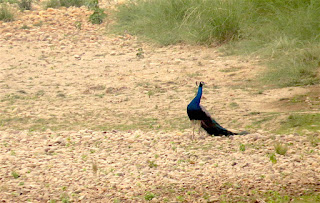

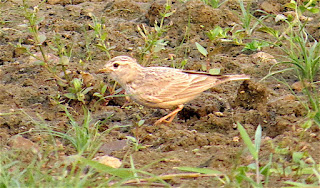
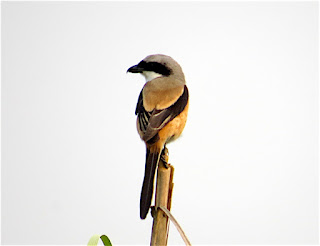

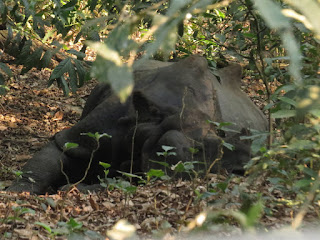


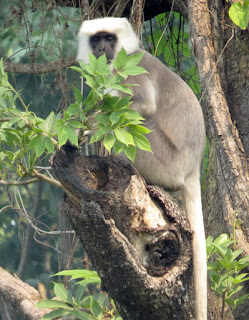
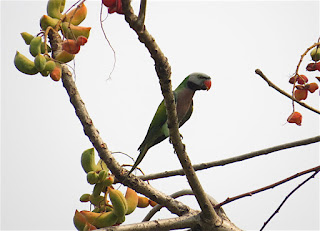


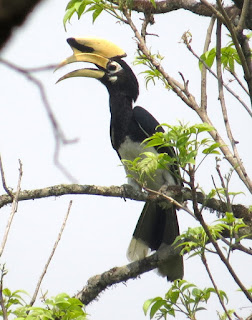
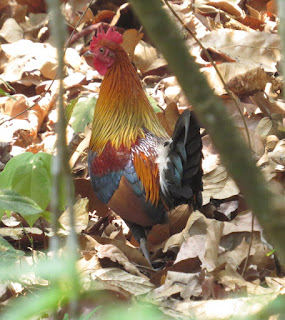


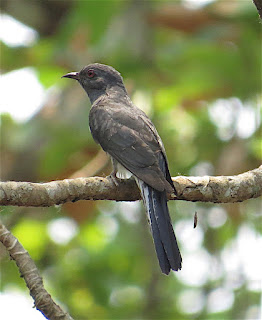

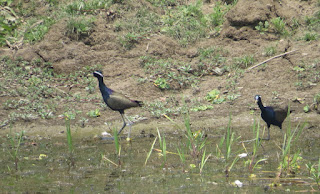

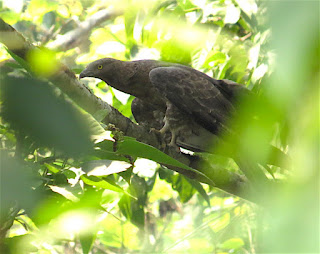








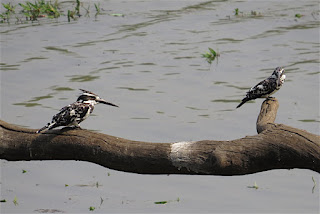

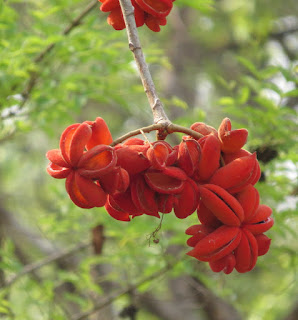
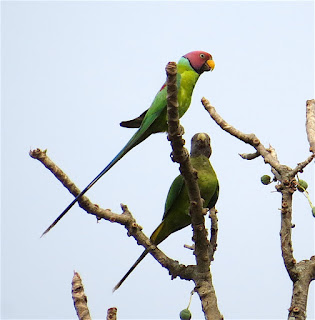










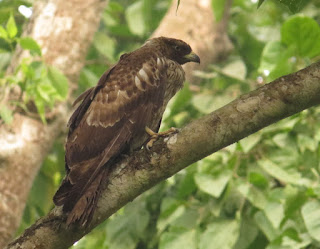



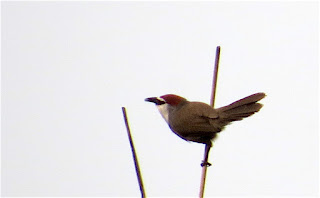

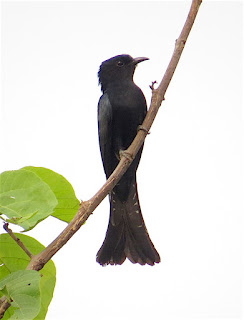



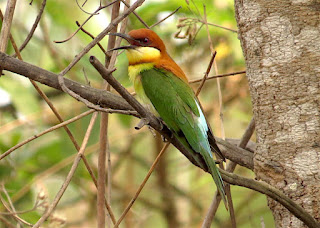









No comments:
Post a Comment